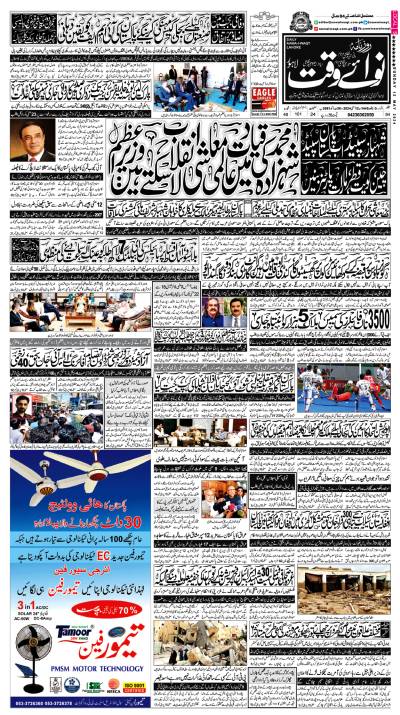MULTAN-Chief Engineer and Technical Advisor Multan Metro Bus project Sabir Khan Sadozai says the mega transportation system in the making in Multan was a cut above the rest, promising more comfort to commuters.
Hundred percent civil work has been completed on the state-of-the-art transportation system that is comprising nine sections covering a distance of 18.5 km with 12.5 km elevated routes, starting from BZU to Kumharan Wala Chowk with an approximate cost of Rs31 billion.
The project is undergoing finishing process, Saddozai claimed, adding that fixing of glasses on metro stations/terminals, installation of escalators and facilities to help disabled persons are in progress at different points and the overall project may complete in next few weeks.
The ground and elevated route of Metro passes through major intersections of northern bypass, Chungi No-6, Chungi No-9, Fish Market, Daulat Gate, Chungi No-14, BCG Chowk and Vehari Chowk to facilitate approximately 96,000 commuters daily.
The first phase of the metro project named as Corridor-I has been launched in 118 Kanals of land acquired with the cost of Rs4.23 billion. “It would help protect utility lines as well, besides providing better transit facilities to masses” Commissioner Multan Division Asad Ullah Khan had said in a statement the other day.
The 18.5 kilometre long track with 12.5 km elevated route has been completed at a record-breaking top speed in history of Multan, project’s media focal person Asghar Khan said. Engineers also had to face difficulties at some points in the city in placing heavy girders. At Mumtazabad, Metro route runs parallel to an already existing bridge. It was a tough point to negotiate as the long arm of the crane was not finding enough space to move. This trouble was shot by employing old technology, a manual-cum-mechanical system involving pulleys, to move over 100 tons heavy girders and place them on the pillars. Those engaged in construction business identify it as Lal Khan and Kalay Khan technology.
A review team of engineers had recommended some different features for Metro Multan compared to Lahore and Rawalpindi to make intra-city travel more comfortable amid itchy climatic condition of Multan, the chief engineer said.
In sharp contrast to use of single glass sheet at Pindi and Lahore which carry the possibility of causing humidity that can bother commuters at Metro stations, layers have been kept simpler after using sandwich panel with thick foam stuffed between two steel layers to protect commuters from direct sun rays.
Over 60 percent heat comes from the roof. That’s why use of glass has been reduced to eight feet only. Over the glass, Louvers of Aluminium were being fixed to cut down heat.
For people with permanent or temporary disability, wheel chairs have been arranged to move safely from one floor to the other and catching up the transit by using the lift. For blinds, special tiles have been fixed to help them move without stick shown, another feature that distinguishes Multan Metro from the rest.
Commuters influx to Metro Lahore, Rawalpindi and Multan were assessed at 96,000 people per day. However, number of commuters availing this facility in Lahore has risen up to 160,000 per day, Saddozai said, hoping that Multan Metro would also attract larger number of people.
Contrary to Lahore and Rawalpindi’s 8.5 km long elevated route, Multan has 12.5 km long bridge. There would be 21 terminals, seven of them at grades (road-level) and 14 others on the bridge (elevated route).
Daewoo Pakistan would operate a fleet of 35 buses initially under direct monitoring by Metro Authority Lahore.
The number of buses operational would increase on the basis of the need as the Metro depot has the capacity of 100 buses parking.
The command & control centre is being built at Chungi No-9 to manage the system through surveillance cameras and computer network. “Next phase is also in the pipeline to be chalked out after running the current phase successfully by the higher authority,” DCO Nadir Chattha had informed media.
Initially, the Punjab government is constructing one feeder route to transport commuters to Metro stations, Sadozai said, adding the buses arriving from different places would converge at this lone feeder route.
Moreover, Rotary has been built at Chungi No-9 and the other being constructed at BCG intersection to pave the way to expand bus operation easier in the future, he said.
Metro Bus system was reaching Multan down the order after its opening in Lahore and Rawalpindi and if the principle of evolution is to be believed, Multan is going to get some upgraded version of the urban transportation system, adds Saddozai.
Sunday, May 12, 2024
Multan Metro Bus project a cut above the rest
Afghan nationals offloaded at Peshawar airport over fake passports
1:34 PM | May 12, 2024
Four suspected terrorists killed in Lahore police encounter
12:42 PM | May 12, 2024
Education for all govt’s priority: DC
May 12, 2024
A Global Problem
May 12, 2024
Symbolic Victories
May 12, 2024
Taxing Toxins
May 12, 2024
Stark Hypocrisy
May 11, 2024
Protection For All
May 11, 2024
Data nexus
May 12, 2024
Urban disruption
May 12, 2024
Media representation
May 12, 2024
Data-driven assessments
May 11, 2024
Coastal conservation
May 11, 2024
ePaper - Nawaiwaqt
Advertisement
Nawaiwaqt Group | Copyright © 2024





